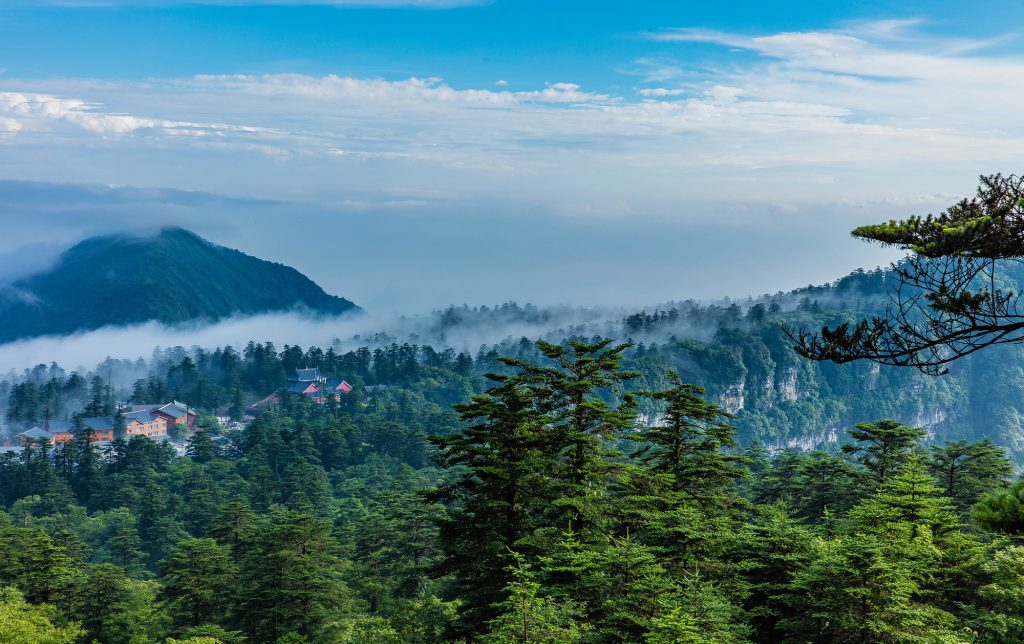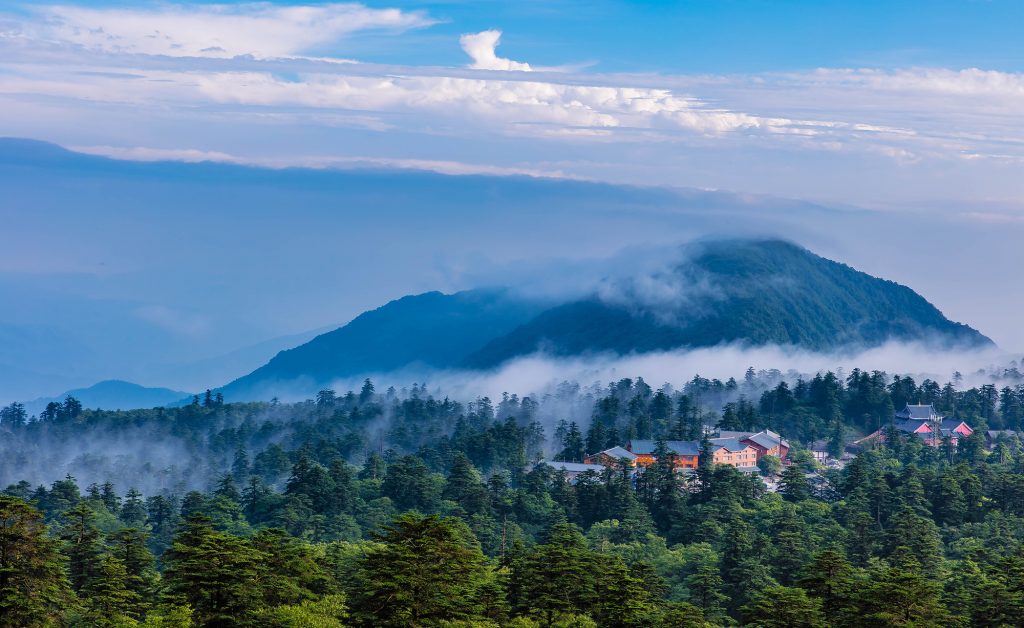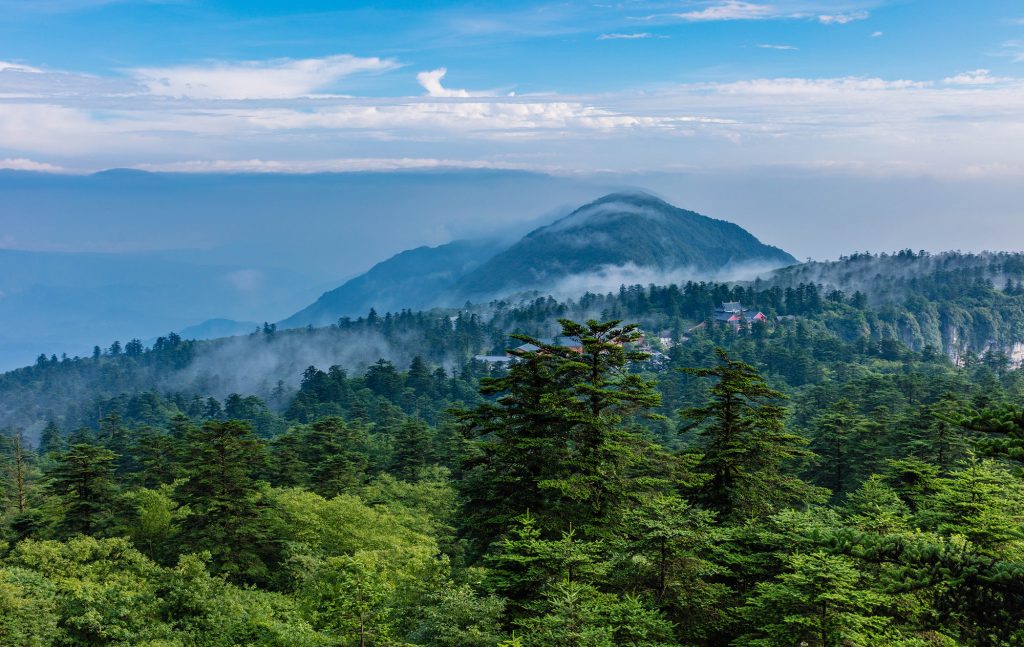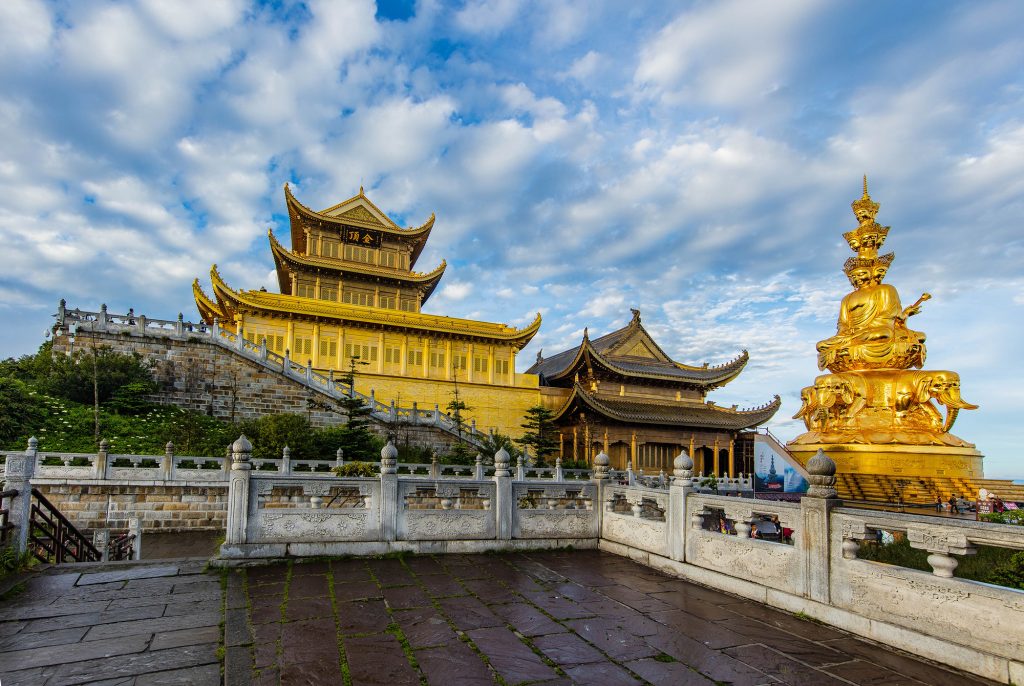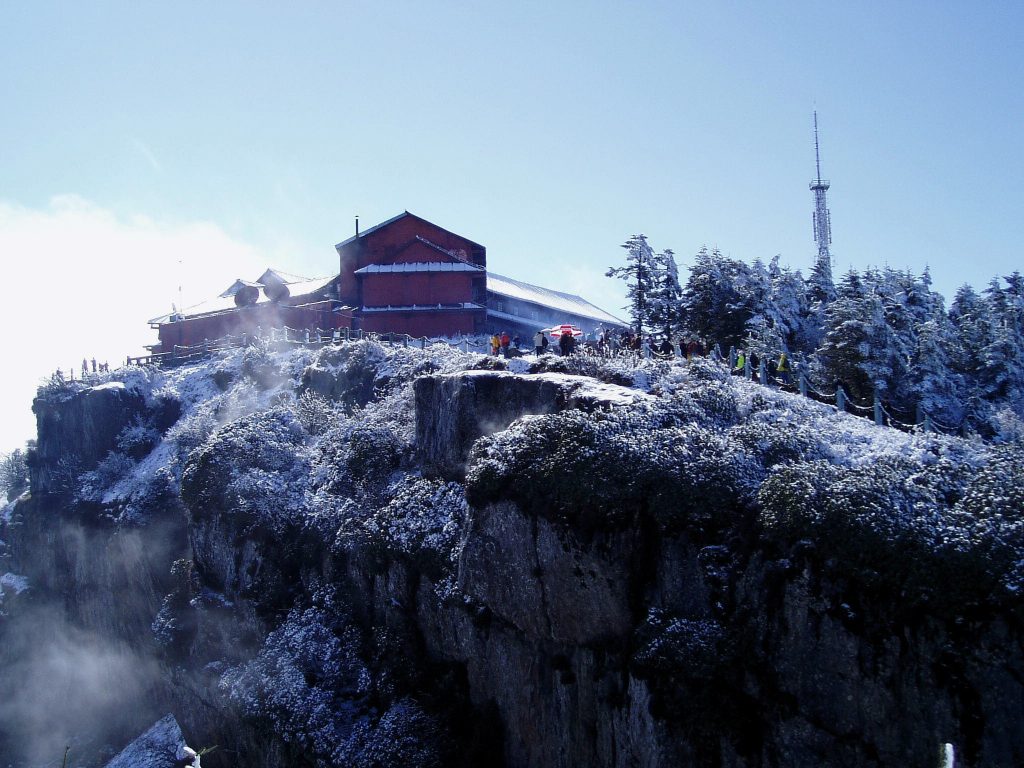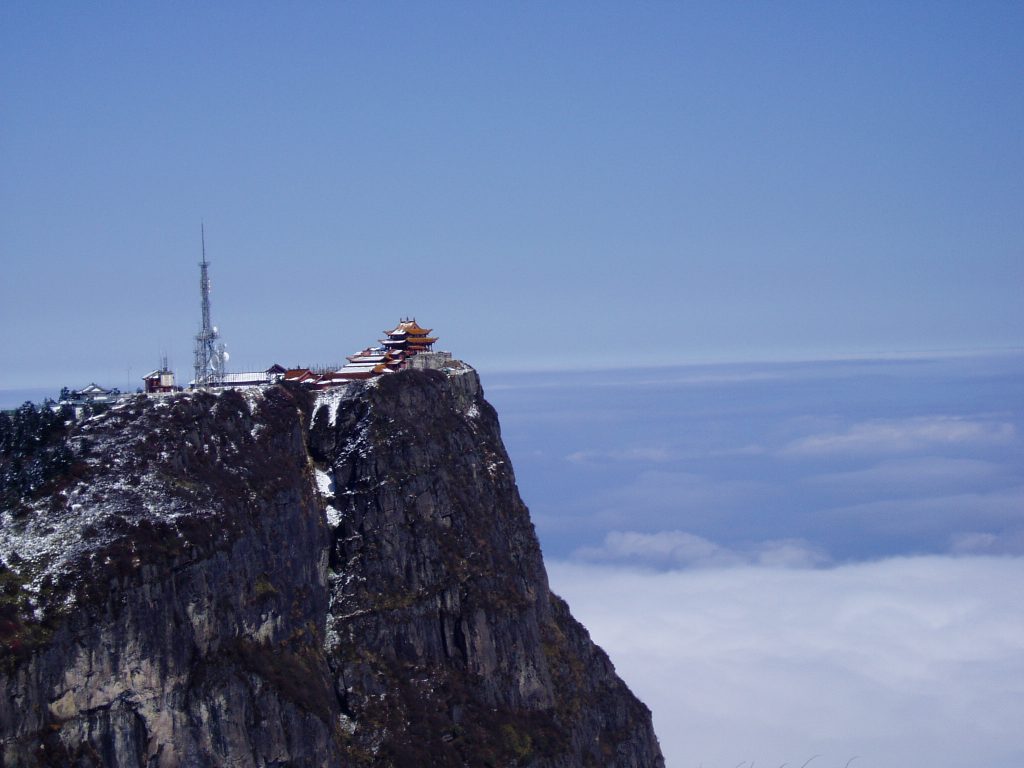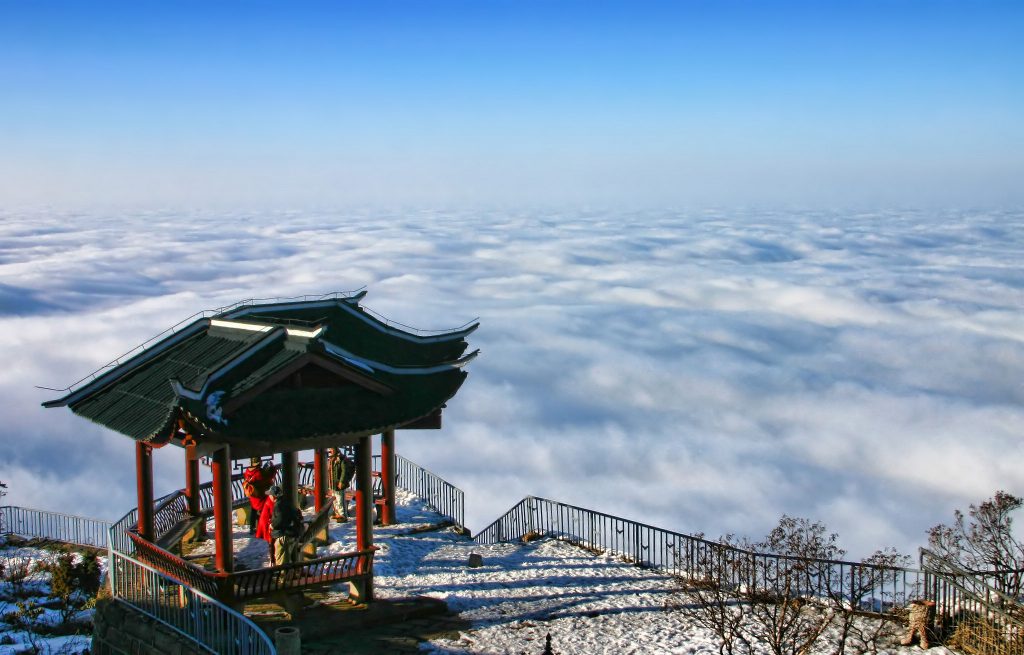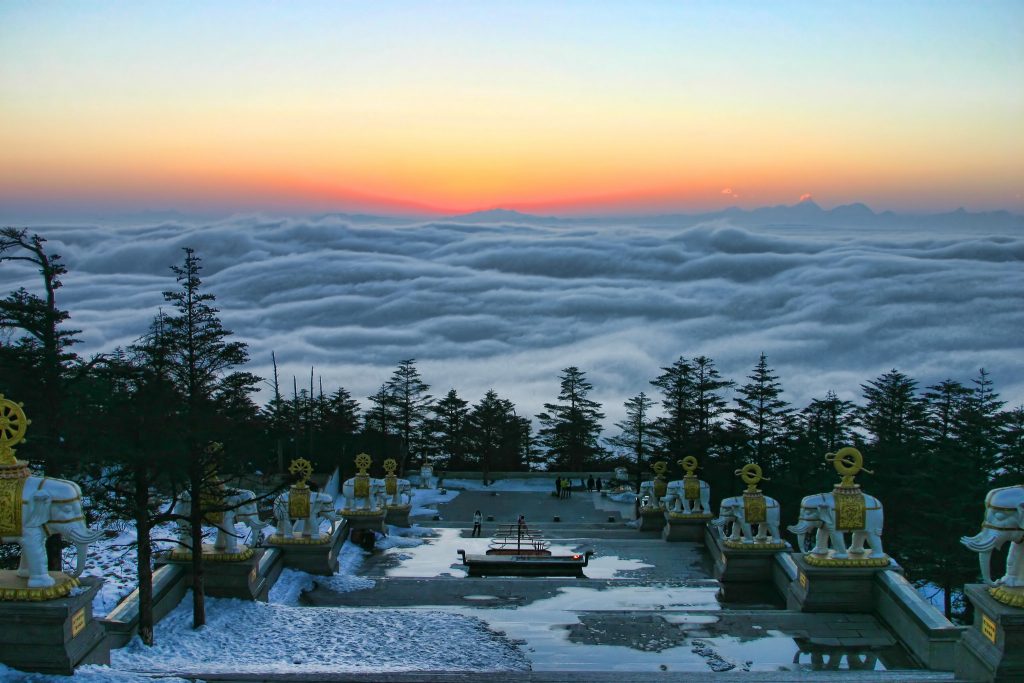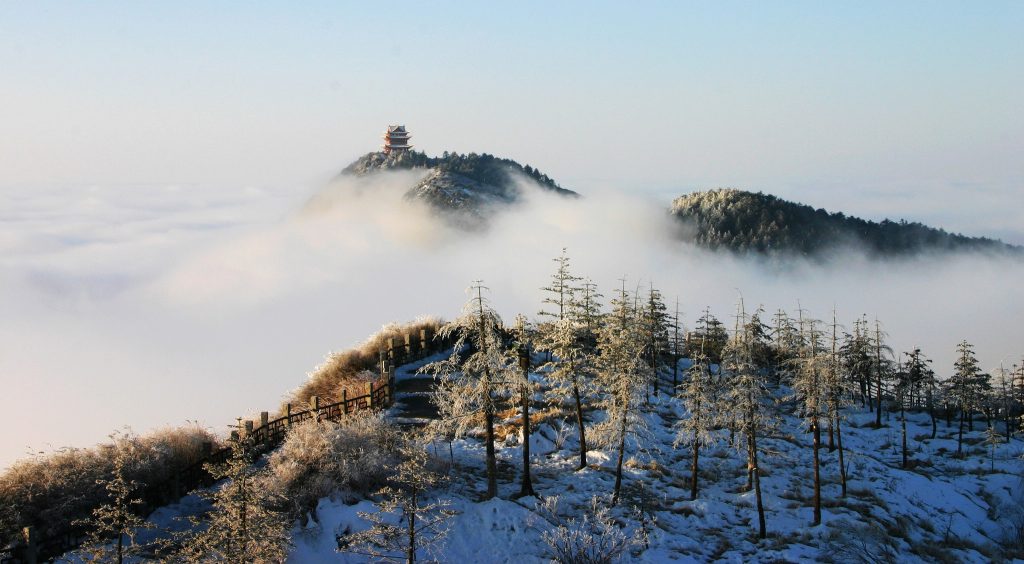Emei Mountain lies 7 kilometers southwest of Emeishan City, 38 kilometers from Leshan Giant Buddha, and 168 km from Chengdu. It is one of the four sacred Buddhist mountains in China. Seen from afar, the undulating mountain range of Emei resembles a girl’s eyebrows; hence, it was so named.
The mountain stretches about 200 kilometers from south to north, with its main peak Golden Summit which is 3,099 meters above sea level. Since ancient times, Mt. Emei has been famous for its natural landscape and Buddhism and Taoism. The main scenic spots on the mountain include Baoguo Temple, Wannian Temple, Fohu Temple, Qingyin Pavilion, Heilongjiang Tunnel, Hongchun Platform, Xianfeng Temple, Jiulao Cave, and Xixiang Pond. These places are at different altitudes with different temperatures. Usually, the temperature at the top of mountain is 15 ℃ lower than at the foot.
Temples on the mountian were built as early as the Eastern Han Dynasty (24B.C.-220 A.D.) and Buddhism was introduced to the mountain during the Jin Dynasty. In the Ming and Qing Dynasties there were more than 150 temples. A legend says that the mountain was where Samantabhadra gave lectures on Buddhism and most of the temples house a statue of Samantabhadra.
Main attractions of Emei Mountain
Baoguo Temple (报国寺): It is the No.1 Buddhist temple Mount Emei Scenic Area. Among the countless temples in Emei Mount, Baoguo Temple is the entrance of it. It is the start of Mount Emei as an important passageway that you must pass when climbing up to the Emei Mountain. With many historical relics in the temple, while visiting the Bao Guo Temple, you can appreciate these historical relics at the same time such as famous colorful glaze porcelain Buddha. The quiet environment and the dense religious atmosphere make it as a charming site for tourists to get touch with the Chinese Buddhism.
Facing the east, Baoguo Temple awaits the arrival of the rising sun in the morning and sends off the setting sun in the dusk. In front of the temple gate there is a pair of stone lions carved in the Ming Dynasty (1368-1644). They are lively, grand and mighty, like door guards protecting the temple as well as the Mt. Emei. A large engraved stone slab hangs above the gate with the name of the temple on it which was written by the Emperor Kangxi (1654-1722) of the Qing Dynasty (1644-1911). The temple has display rooms of historical relics, painting and calligraphy, specimen of creature, motor-driven scenery areas with modern equipment detailed introducing the traffic routes when visiting the Mount Emei and so forth.
Wannian Temple (万年寺): Meaning thousands of years temple in Chinese, it is located in the Mount Emei. This temple is one of the major temples in Mount Emei. It is said that there is a kind of special small frog on the Emei Mountain in the rectangle pond at the right side inside the Wannian Temple. In quiet evening, they will release pleasant sound all the year. All who have heard the sound describe this kind of frog as “Playing Instrument Frog”.
Linyan Temple (灵岩寺): Lingyan Temple is located in the left of high bridge at five kilometers southwest of Baoguo Temple. Established between Sui and Tang dynasty, it was called Huguo Guanglin Temple and Huifu Temple. It was reconstructed during Ming dynasty Hongwu period and Yongle period, and it was called Linyan since then. Ming dynasty was the heyday of Lingyan Temple.
Qingyin Pavilion (清音阁): Qingyin Pavilion looms in Niuxin Mountain, with Heilong River in its left and Bailong River in its right. At confluence canyon there is one black stones, shaped like a cattle heart, therefore the stone is called the Niuxin Stone (cattle heart stone). Under the pavilion there are two Flybridges, and Shuangfei Pavilion stand between the two bridge, two clear streams rush through the bridge.
The Golden Summit (Jin ding, 金顶): It is the highlight of Mount Emei, an important attraction integrating the temples and scenic sites together. In 1983, it was classified as one of the national Han Chinese Buddhist temples. As a wondrous sight-seeing platform and the biggest pilgrimage centre of Chinese Buddhists, it has been crowned as a scenic masterpiece in the Chinese World.
It was constructed during the Eastern Han Dynasty and has been rebuilt several times after being struck by lightning. Golden Summit is in a height of 3,078 meters above the sea level. When standing here, tourists will find that clouds are lower than the peak which ensures to savor the exotic exciting scenes such as magnificent sunrise, clouds sea, mysterious Buddha rays, as well as the holy Saint Lamps.
Highlights of the Golden Summit in Mount Emei
► Magnificent Sunrise: Standing on the Golden Summit with an extremely unique angle to appreciate the sunrise is a fantastic experience in the lifetime. The pre-dawn sky is wonderful. Gradually, God uses the sun to open a line of the sky. Float clouds are colored by the sunlight while some of them are even painted in the gold color. Just a few minutes, the sun is hanging on the sky and light up the earth immediately.
► Clouds Sea: The fine day allows clouds floating in the clear sky freely. Rising from or just being around the countless peaks, clouds form into a white carpet covering on the ground without boundaries. When the breeze blowing and clouds drifting away, the peaks of the mountain turn into hundreds of small islands that being immersed in the sea of clouds. Sometimes there are clouds either above the horizon or in the sky, so people stand between two clouds layers, which make you feel like a supernatural being.
► Buddha Rays: The special feature of the Golden Peak is ‘mysterious Buddha rays’, a natural phenomenon that can be observed several times a month and almost daily in October and November. O¬n the top of the mountain, a circle of violet, indigo, blue, green, yellow, orange and red lights may be observed in the clouds, and you may feel as if you were caught in the circle, which moves with your shadow. This is the famed “precious Emei lights” or “mysterious Buddha rays”.
In the afternoon, the sunbeams break through the cloud cover and build a rainbow in the shape of a closed circle. Whoever looks down from Sheshen Cliff can see his own shadow in the middle of the rainbow. At ancient time, many a Buddhist pilgrim who saw his shadow in this circle of light falsely interpreted it as his having achieved illumination and sprang into the abyss. But now, the o¬ne who sees such miraculous scene would be considered as a lucky guy and envied by many people.
► Saint Lamps: The Saint Lamps, also known as Buddhism Lights, are lighting uup the black sky during the night. This scene always appears around the Sheshen Cliff. From one green point light, then more and more “lamps” are lighted up and spread all over the sky. This exotic appearance is mysterious and it is hard to explain how it is caused. The saint lamps can be seen under four conditions: firstly, the weather must be fine right after the rain; secondly, there is no moon in the sky; thirdly, there are no clouds layers at the foot of the mountain; fourthly, there are no heavy wind and rain on top of the mountain. As for the conditions, it is clear that the saint lamps are really hard to be observed.
Top 10 Sceneries of the Emei Mountain
The ten old sceneries of Mount Emei include the Lucky Light at the Golden Summit, the Moonlit Night in Elephant Pool, the Godly House of Nine Sages, the Morning Rain at Hongchun, the Snow on the Daping Peak, the Autumnal Sound at the Double Bridge, the Autumn Wind over the Baishui Pool, the Clouds of Sea on the Luo Peak, the Smoke Cloud in the Thunder Cave, the Jade Bamboo Shoot and the Evening Bell of Shengji.
Ten new sceneries of the mountain include the Golden Buddha on Golden Summit, Ten Thousand Buddhas, the Dengxiaoping’s Praise of the Mountain, the Monkeys in Tranquil Valley, Soft Music from Peaceful Lake, the First Pavilion on the Cliff, the Inscriptions on Precipices, the Most Beautiful Waterfall in the world, the Meeting Square and the Staring Point of Great Mountains.
Emei Mountain Travel guide
Entrance fee: RMB185 per person in peak season, RMB110 in off-peak season
Mt. Emei Cable Car: There are two cables cars on Mt. Emei. The Jinding (Golden Summit) Cable Car starts at Jieyin Hall and ends at Golden Summit. The maximum capacity is 101 passengers. It runs between 05:30 and 18:00. The travel time is 3 minutes. Wannian Cable Car connects Wannian Temple parking lot and Wannian Temple. It runs between 06:40 and 18:00.
Sightseeing shuttle bus: There are mainly three lines 1) Entrance of Mt. Emei Scenic Area (Boguo Temple) – Leidongping Parking Lot; 2) Wannin Temple Parking Lot (Wuxiangang Parking Lot) – Leidongping Parking Lot; 3) Entrance of Mt. Emei Scenic Area (Boguo Temple) – Wannin Temple Parking Lot
Accommodation: Visitors can choose to stay on the mountain or the downtown area of Mt. Emei. The various types of hotels, from 5-star hot spring hotels, comfortable 4-star hotels, panda or teddy bear themed boutique hotels to budget hotels and local guesthouses will meet different needs. It costs much more if booking the hotel nearby Golden summit than those hotels around Baoguo Temple at the foot of the mountain.
How to Get Mount Emei
The location of Mount Emei is not a big city, thus tourists are advised to go to Chengdu first, then go to Mount Emei from Chengdu. Here gives three options for tourists from Chengdu to Mount Emei. Option 1 is faster than option 2 and costs more, and option 3 is recommended to tourists with a large budget.
Option 1: Train(Recommended)
Everyday, there are about 20 trains from Chengdu to Emeishan, which are divided into four types, fast train(K), fast nonstop train(T), high speed train(G) and inter-city train(C). These trains start from Chengdudong Railway Station(成都东站), Chengdunan Railway Station(成都南站) and Chengdu Railway Station(成都火车站) and stop at Emei Railway Station(峨眉火车站) and Emeishan Railway Station(峨眉山火车站). Chengdu Railway Station is located in No.1, Zhandong road, Jinniu district, Chengdu, and tourists could go to this railway station by subway Line 1 and Line 7, and by public buses like No. 9, No. 16, No. 17, No. 27, No. 34, No. 36, No. 50, No. 54, No. 55, No. 65, ect. Chengdudong Railway Station is located in Qingyijiang road, Chenghua district, and tourists may get to there by taking a public bus, like No. 2, No, 38, No. 40, No.91, No. 101, No, 149 public bus. Chengdunan Railway Station is located in Tianfu Dadao, Wuhou district, and tourists could go to here by subway Line 1 and Line 2, or by public buses like No. 16, No, 19, No. 49, No. 112, No. 76, No. 111, etc.
Emei Railway Station is in the east of Mount Emei Scenic Area, about 10 kilometers away from the scenic area. From this railway station to the scenic area, tourists are advised to take a taxi, which costs about 35 yuan. Still tourists could walk about 830 meters to Yaozhongxiao bus stop, take No. 7 public bus and get off at the terminal stop, or tourists may take No. 8 public bus, get off at Emenshan Railway Station, then transfer to No. 7 public bus. Emeishan Railway Station is located in east of Mount Emei Scenic Area, about 5 kilometers away from it. After getting out of Emeishan Railway Station, tourists could take a taxi to the scenic area, and taxi fare is about 15 yuan.
Here is some information about trains from Chengdu to Emeishan:
| Train No. | Departure | Arrival | Duration | Business Class Seat/ CNY | First Class Seat/ CNY | Second Class Seat/ CNY | Hard Seat/ CNY | Hard Sleeper / CNY | Soft Sleeper/ CNY |
| C6253 | Chengdudong 06:18 | Emaishan 07:23 | 01:05 | 83 | 52 | ||||
| T8865 | Chengdu 07:51 | Emei 09:59 | 02:08 | 23.5 | 69.5 | 105.5 | |||
| G8669 | Chengdunan 09:27 | Emeshan 10:46 | 01:19 | 185 | 99 | 62 | |||
| K985 | Chengdu 16:03 | Emei 18:03 | 02:00 | 23.5 | 69.5 | 105.5 | |||
| G8681 | Chengdunan 20:59 | Emeishan 22:12 | 01:13 | 185 | 99 | 62 |
Option 2: Bus
Long distance bus from Chengdu to Emeishan starts at Chengdu Xinnanmen Bus Station and stops at Baoguo Temple Scenic Area in Emeishan which is a part of Mount Emei Scenic Area and in its east side. The bus travels a distance of 143 kilometers and takes about 2.5 hours, with a ticket of 35 yuan. Usually speaking, it starts at 07:40, 08:30, 09:20, 10:10, 11:00, 12:00, 12:50, 13:40, 14:30, 15:20, 16:10, 17:00, 18:00, and ends at 19:00. Chengdu Xinnanmen Bus Station is located in No. 2, Xinnan road, Wuhou district. There are lots of buses passing though Chengdu Xinnanmen Bus Station, like No. 6, No. 21, No.28, No. 49 No. 35, No. 55 and No. 237 public bus.
Option 3: Car Rental
Chartering a car is fast and convenient for tourists’ travelling, but it is a bit expensive. If you are in a large group of 7 or so, or if you are in a big budget, you could charter a private car with an experience driver. Certainly, you could book a transfer service from a travel agency, like Topchinatravel. Our transfer service includes car, driver and tour guide, which may be adjusted according to your needs and requirements. If you book a transfer service from a travel agency, please make it at least one day ahead of time, otherwise they do not have enough time to arrange a car for you.


